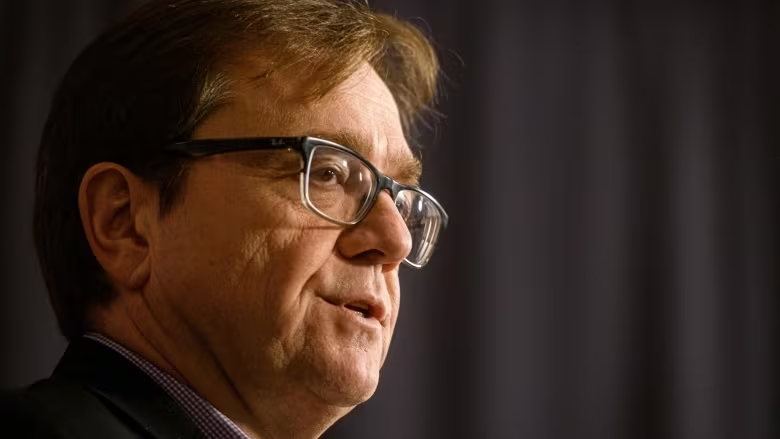Framework meant to reduce emissions while letting production increase 12% above 2019 levels
The Liberal government announced its regulatory framework for capping emissions in the oil and gas sector Thursday — a national cap-and-trade system that it says will set emissions limits without restricting production.
"Oil and gas is the largest emitting sector in Canada. And unlike almost every other sector of our economy, pollution from the oil and gas sector is still going up," Environment Minister Steve Guilbeault said Thursday.
"We owe it to Canadians, and to the rest of the world, to address these emissions as we owe it to our workers and businesses to ensure Canada's well-earned reputation for energy innovation remains our strong suit for the 21st century."
The framework proposes to cap 2030 emissions at 35 to 38 per cent below 2019 levels to reach the government's goal of reducing carbon emissions in the sector to net zero by 2050. The oil and gas sector is responsible for 28 per cent of Canada's emissions.
The government said it is publishing the framework now to give the industry and others time to provide input on the forthcoming draft regulations, which it says it will publish in mid-2024.
The sub-sectors of the oil and gas sector that will be affected by the framework include liquefied natural gas producers, conventional and offshore oil producers, oil sands producers and natural gas processors.

Tell us what you think!
Help shape the future of CBC article pages by taking a quick survey.
The cap would apply to upstream emissions from oil and gas development in Canada. Emissions from refineries are not covered under the cap — they fall under the clean fuel regulations.

Canada introduces emissions cap for oil and gas industry
6 hours ago
The federal government has revealed how it will set an upper limit on greenhouse gas emissions through a cap-and-trade system for the country's biggest emitter, the oil and gas industry.
"We looked at whether or not it would make sense to apply the cap to the refiners as well and the conclusion was that it did not lead to further emissions reductions than the ones we are already getting from the clean fuel standard," Guilbeault said.
Under the framework, oil and gas facilities will be given an allowance for each tonne of carbon they emit, with fewer allowances being given out over time.
To comply with the framework, facilities either have to reduce their emissions or buy allowances from other facilities that have reduced their emissions.
The government says the cap-and-trade system it plans to implement will only result in emissions reductions of about 20 to 23 per cent below 2019 emission levels, and should allow industry to increase production 12 per cent above 2019 levels.

To get to the stated goal of reducing emissions 35 to 38 per cent below 2019 levels, the sector will be allowed to use offset credits or pay into a decarbonization fund that will invest in future greenhouse gas emissions reductions.
The government says the framework has been designed to work with other emissions-reduction policies, including methane regulations and carbon pricing. That means emissions reductions in the oil and gas sector will count toward the sector's obligations under multiple government policies.
The Canadian Association of Petroleum Producers (CAPP) said in a media statement that adding emissions cap regulations to existing carbon pricing and methane policies creates a layer of complexity that could hamper investments in clean energy projects.
CAPP also said the "unintended consequences" of the framework "could result in significant curtailments — making this draft framework effectively a cap on production."
"CAPP believes the proposed policy risks triggering unforeseen socioeconomic consequences, not the least of which is likely to be higher energy prices for Canadians," the statement said.
Targets are more modest than expected
The limits are not as aggressive as the original 2030 target of reducing emissions in the sector by 42 per cent below 2019 levels. One source told CBC News that the government set less ambitious targets in order to avoid legal and constitutional fights with provinces.
Last week, Guilbeault said two recent court decisions forcing Ottawa to tread more carefully on climate policy affecting provinces pushed the federal government to reconsider its emissions cap plan.
The first was a Supreme Court decision that said a federal law governing environmental impact assessments stepped into provincial jurisdiction by applying to some projects that should have been outside of Ottawa's control.
The second was a Federal Court decision that struck down Environment Canada's designation of all plastic manufactured items as "toxic." The court said the category of plastic manufactured items was too broad for a single designation. The decision also touched on federal-provincial distribution of powers.
Energy and Natural Resources Minister Jonathan Wilkinson said that in drafting the framework, the federal government set the 2026-2030 timeline for implementation and the 35 to 38 per cent target by taking into account what is technically achievable.
"If you're asking to be done something that simply can't be done, then what you're going to do is shut down production and simply send it to other countries," Wilkinson said.
"It's important that you found this on what actually can be done and not simply on what you might like to see done."
Saskatchewan, Alberta blast the plan
Alberta Premier Danielle Smith issued a statement Thursday calling the framework an "intentional attack by the federal government on the economy of Alberta and the financial well-being of millions of Albertans and Canadians."
Smith said Alberta owns its resources and, under the Constitution, has exclusive jurisdiction to develop and manage them.
"Justin Trudeau and his eco-extremist Minister of the Environment and Climate Change, Steven Guilbeault, are risking hundreds of billions of investments in Alberta's and Canada's economy," she said.
My response to the federal government’s oil and gas emissions cap, announced today by Steven Guilbeault: <a href="https://t.co/ZaLuDh85bq">pic.twitter.com/ZaLuDh85bq</a>
—@PremierScottMoe
Saskatchewan Premier Scott Moe said the emissions reductions contained in the framework will burden the oil and gas sector "with more red tape and regulations."
"These new federal policies will have serious economic impacts on Canadians and limit our sustainable Canadian energy products from providing heat and electricity to the world," he said in a media statement.
Moe said he remains opposed to an oil and gas emissions cap and his government "will protect our constitutional right to build our economy in accordance with the priorities of Saskatchewan families and businesses."
A statement from the provincial government in St John's said the framework needs detailed analysis and further discussion with the federal government.
"Currently, all impacts of this proposed greenhouse gas emissions cap on Newfoundland and Labrador facilities are not clear," the statement said.
"Newfoundland and Labrador remains committed to working with the federal government to achieve the net zero 2050 greenhouse gas emission reduction target."
Environmentalists criticize timeline
Rick Smith, president of the Canadian Climate Institute, described the framework as a "sensible approach" but criticized the government's timeline.
"There's no need to push off implementation to 2026 or later," he said.
"The approach to capping oil and gas emissions announced today is reasonable and necessary. These regulations should be finalized and implemented without further delay."
Caroline Brouillette, executive director of Climate Action Network Canada, welcomed the framework and called it an example of backing "diplomacy with domestic action."
"Now we must double down to ensure that draft regulations are tabled by February and that the oil and gas industry finally does its fair share of the national climate effort," she said.

Federal ministers defend timing of emissions cap
16 hours ago
Energy Minister Jonathan Wilkinson and Environment Minister Steven Guilbeault say it takes time to come up with a cap framework and for the sector to reach certain targets.
The Pembina Institute also welcomed the cap, describing it as "responsible and realistic."
"The regulatory framework released today is an important step toward meaningful reductions in emissions from the oil and gas sector," said the institute's Janetta McKenzie.
NDP environment critic Laurel Collins, however, said the framework misses the mark and panders to the oil and gas sector's CEOs.
"At a time when people expect the government to take on the climate crisis, the Liberals instead have listened to oil and gas lobbyists, giving them an oil and gas emission cap framework that's low, riddled with loopholes and won't put Canada back on the right path for meeting our emission targets," she said.

Add some “good” to your morning and evening.
A variety of newsletters you'll love, delivered straight to you.
*****
Credit belongs to : www.cbc.ca
 MaharlikaNews | Canada Leading Online Filipino Newspaper Portal The No. 1 most engaged information website for Filipino – Canadian in Canada. MaharlikaNews.com received almost a quarter a million visitors in 2020.
MaharlikaNews | Canada Leading Online Filipino Newspaper Portal The No. 1 most engaged information website for Filipino – Canadian in Canada. MaharlikaNews.com received almost a quarter a million visitors in 2020.







